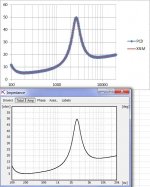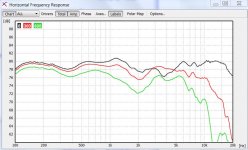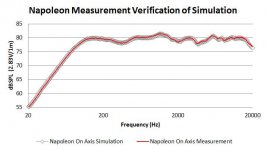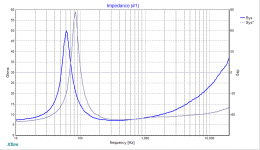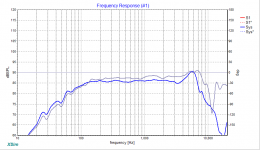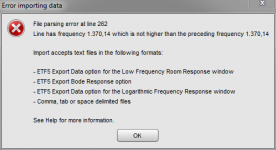Heinrich,
Thank you! LoudspeakerSoft looks like the tool I'm looking for. It seems intuitive to use, but is there an English version of the accompanying pdf?
Thanks again,
Dave
Thank you! LoudspeakerSoft looks like the tool I'm looking for. It seems intuitive to use, but is there an English version of the accompanying pdf?
Thanks again,
Dave
Hi Dave,
maybe Marcel (Mabat) can help. As far as I know he is still active in this forum.
Regards
Heinrich
PS: Nice "Red Porsche Killer" as Avatar (http://www.werner.de/kultschmiede/kultrpk.html)
maybe Marcel (Mabat) can help. As far as I know he is still active in this forum.
Regards
Heinrich
PS: Nice "Red Porsche Killer" as Avatar (http://www.werner.de/kultschmiede/kultrpk.html)
Last edited:
Hi Heinrich,
I tried it tonight but unfortunately it crashed on my Win7 machine. I also couldn't find an easy way to add wire connectors or parallel components. I guess the hunt continues!
Thanks for the suggestion though, it was worth a shot.
Dave
I tried it tonight but unfortunately it crashed on my Win7 machine. I also couldn't find an easy way to add wire connectors or parallel components. I guess the hunt continues!
Thanks for the suggestion though, it was worth a shot.
Dave
Hi Dave,
it works pretty well on my Win7 machine.
In short: Program and datafiles have to be in the same Directory.
Polarmap is a little Buggy pls avoid it.
Wiring: Strg + mouse left
Rotation: space
Regards
Heinrich
it works pretty well on my Win7 machine.
In short: Program and datafiles have to be in the same Directory.
Polarmap is a little Buggy pls avoid it.
Wiring: Strg + mouse left
Rotation: space
Regards
Heinrich
Last edited:
Hi Heinrich
Took me a minute to figure out "Strg" is "Ctrl" on an english keyboard but between that and "space", i can now draw the circuit just fine.
I also put the executable in the same directory as the frd and zma files. An frd file loads fine, but upon loading the zma file, the program crashes.
Are there specific formats required for zma beyond the usual? I use standard .zma formats, eg starting at the top:
18.4955, 4.522599, 19.40319
22.1946, 4.70853, 22.3176
25.8937, 4.89381, 24.94067
29.5928, 5.115155, 27.8849
33.2919, 5.434851, 30.70305
36.991, 5.794418, 32.84942
40.6901, 6.187373, 34.81445
Does the program have incompatibilities with any common anti-virus programs? Does it need java and are there version compatibility limitations there?
Thanks, getting closer I think!
Dave
PS on the avatar, I think the 'bike" is powered by Skil chainsaw motors. It's so outrageous and speaks to some of the best insanity in human kind, I loved it.
Took me a minute to figure out "Strg" is "Ctrl" on an english keyboard but between that and "space", i can now draw the circuit just fine.
I also put the executable in the same directory as the frd and zma files. An frd file loads fine, but upon loading the zma file, the program crashes.
Are there specific formats required for zma beyond the usual? I use standard .zma formats, eg starting at the top:
18.4955, 4.522599, 19.40319
22.1946, 4.70853, 22.3176
25.8937, 4.89381, 24.94067
29.5928, 5.115155, 27.8849
33.2919, 5.434851, 30.70305
36.991, 5.794418, 32.84942
40.6901, 6.187373, 34.81445
Does the program have incompatibilities with any common anti-virus programs? Does it need java and are there version compatibility limitations there?
Thanks, getting closer I think!
Dave
PS on the avatar, I think the 'bike" is powered by Skil chainsaw motors. It's so outrageous and speaks to some of the best insanity in human kind, I loved it.
Last edited:
Hi Dave,
no there are no special requirements for Loudspeakersoft and - as far as I know - no conflicts with anti-virus programs.
Normally frd, txt and zma files should work fine
but LoudSoft reacts a little sensitive to some file names (blank etc.).
ZMA
10.000 7.165 11.289
10.140 7.172 11.443
10.282 7.178 11.594
10.427 7.184 11.738
10.573 7.190 11.884
FRD
2.951 63.2331 -3.0030
2.991 63.2330 -3.0235
3.032 63.2328 -3.0441
3.073 63.2326 -3.0854
Pls check this.
Regards
Heinrich
no there are no special requirements for Loudspeakersoft and - as far as I know - no conflicts with anti-virus programs.
Normally frd, txt and zma files should work fine
but LoudSoft reacts a little sensitive to some file names (blank etc.).
ZMA
10.000 7.165 11.289
10.140 7.172 11.443
10.282 7.178 11.594
10.427 7.184 11.738
10.573 7.190 11.884
FRD
2.951 63.2331 -3.0030
2.991 63.2330 -3.0235
3.032 63.2328 -3.0441
3.073 63.2326 -3.0854
Pls check this.
Regards
Heinrich
Hi Heinrich,
Thank you so much for your help with this.
The ZMAs and FRDs needed by Loudspeaker Soft are a bit non-standard: no commas alowed, and one space between columns. For example, XSim wouldn't even accept input in this format and Calsod and PCD are fine with the commas and extra spaces.
When changed to this format, Loudspeaker Soft works perfectly. I attached one file showing 3 angles of horizontal response.
To validate these tools, I compared simulated responses of XSIM, Loudspeaker Soft and PCD using real measured files, and attached their simulations. They’re simulation outcomes are all almost identical. There are some differences up to several points of dB in XSim. It looks like Xsim applies some smoothing, where the other don't. I also attached a comparison between PCD's simulations and a measured system build response: effectively identical, so it’s safe to say all 3 of these tools are accurate (within the limitations of XSIM’s smoothing).
I also compared impedance simulations, identical for all 3.
This is going to be very useful going forward!
Do you know if Loudsoft will export FRD or ZMAs of the simulated system responses? That's all it needs to be complete IMO.
Thanks again for helping with the translation.
Dave
Thank you so much for your help with this.
The ZMAs and FRDs needed by Loudspeaker Soft are a bit non-standard: no commas alowed, and one space between columns. For example, XSim wouldn't even accept input in this format and Calsod and PCD are fine with the commas and extra spaces.
When changed to this format, Loudspeaker Soft works perfectly. I attached one file showing 3 angles of horizontal response.
To validate these tools, I compared simulated responses of XSIM, Loudspeaker Soft and PCD using real measured files, and attached their simulations. They’re simulation outcomes are all almost identical. There are some differences up to several points of dB in XSim. It looks like Xsim applies some smoothing, where the other don't. I also attached a comparison between PCD's simulations and a measured system build response: effectively identical, so it’s safe to say all 3 of these tools are accurate (within the limitations of XSIM’s smoothing).
I also compared impedance simulations, identical for all 3.
This is going to be very useful going forward!
Do you know if Loudsoft will export FRD or ZMAs of the simulated system responses? That's all it needs to be complete IMO.
Thanks again for helping with the translation.
Dave
Attachments
I have been playing around with conjugate load matching and XSIM and the results have been accurate with my measurements.
Anyone using the series notch module? I can't get it to do anything. The shunt module works just fine.
I've also been using this great program but somehow cannot import one particular zma file. I've carefully examined it and compared to others that are accepted but for some reason unknown to man (me) the program simply refuses to download it 🙁
Inside the zip file there are 4 files, respectively the frd and zma curves for two drivers. I have no problems with 12MU (uploaded for comparing) but 12W-8524G00.zma is not accepted.
Can someone please help?
Inside the zip file there are 4 files, respectively the frd and zma curves for two drivers. I have no problems with 12MU (uploaded for comparing) but 12W-8524G00.zma is not accepted.
Can someone please help?
Attachments
cochinada,
REW helped me when tried to import there.
Picture 1 showing REW error dialog.
Picture 2 line 261/262 shown highlighted amend was in line 262 changing 4 to 5.
Picture 3/4 in grey plot your working zma/frd files in blue plot the one with broken zma.
REW helped me when tried to import there.
Picture 1 showing REW error dialog.
Picture 2 line 261/262 shown highlighted amend was in line 262 changing 4 to 5.
Picture 3/4 in grey plot your working zma/frd files in blue plot the one with broken zma.
Attachments
Thanks a lot BYRTT!
Sometimes when I'm tracing these curves the mouse jumps. It must have been something like that but I would never suspect of such thing 😀
Sometimes when I'm tracing these curves the mouse jumps. It must have been something like that but I would never suspect of such thing 😀
Anyone using the series notch module? I can't get it to do anything. The shunt module works just fine.
Hi Pano,
Both ( types of ) notch modules work for me ( I'm still running XP SP3 ) .
🙂
Dear Bwaslo,
This SW looks very promising. I just did check the Phase linear Passive Xover
CoSyne3 example, and did find some strange thing:
if you check the power dissipation of R8, it is ridiculously high! it is, just if at the calculation the HPF below that would not be taken into account.
other than this, when calculating power dissipation, I think (for getting near to real world data) you might use a Pink (or brown) noise like energy distribution wide band noise comming from the amplifier, with 6 dB crest at least (worst case)....
What do you think?
BR,
Tamas
This SW looks very promising. I just did check the Phase linear Passive Xover
CoSyne3 example, and did find some strange thing:
if you check the power dissipation of R8, it is ridiculously high! it is, just if at the calculation the HPF below that would not be taken into account.
other than this, when calculating power dissipation, I think (for getting near to real world data) you might use a Pink (or brown) noise like energy distribution wide band noise comming from the amplifier, with 6 dB crest at least (worst case)....
What do you think?
BR,
Tamas
ttako,
Yup, that sort of demonstrates the point of being able to check such things.
Here is the crossover as is actually in use at this time -
http://libinst.com/Xsim/Cosyne%20I%20Lin%20Phase%20As%20Built%20Dec%202014.dxo
But there does need to be some 'calibration' on simulation power dissipations. I think that even with the Cos3 design as in the example, you'd find that R8 wouldn't get all that hot usually. The average power into a loudspeaker (at least for non-pro and non-loud-rock) is usually quite low. If R8 were only a 10W resistor, you'd probably not notice it get very hot in normal use.
Yup, that sort of demonstrates the point of being able to check such things.
Here is the crossover as is actually in use at this time -
http://libinst.com/Xsim/Cosyne%20I%20Lin%20Phase%20As%20Built%20Dec%202014.dxo
But there does need to be some 'calibration' on simulation power dissipations. I think that even with the Cos3 design as in the example, you'd find that R8 wouldn't get all that hot usually. The average power into a loudspeaker (at least for non-pro and non-loud-rock) is usually quite low. If R8 were only a 10W resistor, you'd probably not notice it get very hot in normal use.
Hi Bwaslo,
Yes, indeed, some calibration is needed 🙂 The same apply of course also for the power Dissipation calculation for the speakers...
Anyhow Did you think about my suggestion? Alternatively Crest factor could be also User selectable (6dB/ 9dB/12dB/15dB/18dB/21dB) i don´t think more options would be needed.
Back to the very example, are you sure, the Power dissipation calculation does take the HPF in front of R8 into account?
Thanks,
Tamas
Yes, indeed, some calibration is needed 🙂 The same apply of course also for the power Dissipation calculation for the speakers...
Anyhow Did you think about my suggestion? Alternatively Crest factor could be also User selectable (6dB/ 9dB/12dB/15dB/18dB/21dB) i don´t think more options would be needed.
Back to the very example, are you sure, the Power dissipation calculation does take the HPF in front of R8 into account?
Thanks,
Tamas
Last edited:
here isn't an HPF in front of the resistor, that stuff is all an all-pass filter (or started out that way before fine tweaking). Note that ground isnt carried through that circuit. The HPF is the capacitor that R8 bridges, and the following shunt inductor before the tweeter.
I'm not eager to add too many extra oddities to Xsim, it seems to be scaring away too many people as it is! As the weighting to apply is a judgment call anyway, it seems best to let people derate from the CW values as they wish. I usually use about 5% at treble, 10% at mid, 15% at bass, but it really depends on the music, user, and what kind of application. Some may want to go 100% on all, even though no one who has a clue applies constant sine waves to a tweeter!
I'm not eager to add too many extra oddities to Xsim, it seems to be scaring away too many people as it is! As the weighting to apply is a judgment call anyway, it seems best to let people derate from the CW values as they wish. I usually use about 5% at treble, 10% at mid, 15% at bass, but it really depends on the music, user, and what kind of application. Some may want to go 100% on all, even though no one who has a clue applies constant sine waves to a tweeter!
- Home
- Design & Build
- Software Tools
- XSim free crossover designer

